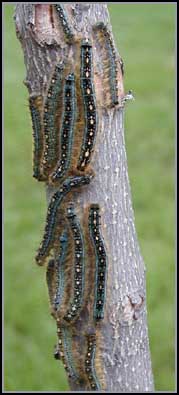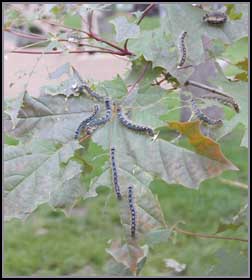Caterpillars flourish in spots
This article submitted by Michael Jacobson on 6/7/00.
 Elmer Neu would like to rid his Rice Lake property of the creatures he describes as "ugly as sin." He'd like to annihilate the caterpillars infesting his trees, his porch, his concrete planters and walkways, and even the paneling and roof of his house.
Elmer Neu would like to rid his Rice Lake property of the creatures he describes as "ugly as sin." He'd like to annihilate the caterpillars infesting his trees, his porch, his concrete planters and walkways, and even the paneling and roof of his house.
In the midst of another population outbreak of the forest tent caterpillar around Rice Lake this spring, Neu has tried to combat the blue bodied creatures with white spots on their backs by spraying his trees with a microbacterial insecticide. Bt kills caterpillars while dissolving quickly enough to have no effect on other wildlife or the lake.
Neu estimates that he and his neighbors on Cyrilla Beach Point have killed millions and millions of caterpillars. Neu has sprayed his trees, siding, porch, and even his roof to kill the caterpillars. "My roof was solid caterpillars last week," he explained. "My roof was alive."
Usually he sprays several times a week. Then he sweeps the walkway, the porch, the siding, the picnic table, the concrete planters. If not for caterpillars, then for their ever-present droppings.
He avoids squashing the caterpillars, as they leave stains.
But he knows he won't win without Mother Nature's help. All the creatures he has killed has lessened the nuisance on his property.
"You come out here at night, and you can hear them eat," Neu said. "It's unbelievable. It's scary."
 His trees by the water hardly have a leaf on them. The caterpillars won't touch the maple trees in back of his house, but the other oak and basswood trees only have leaves on the low branches, which Neu protects by spraying. "It's hard to believe they can eat a tree that clear of leaves," he said, while looking at an oak tree that is as bare as it would be in mid-December.
His trees by the water hardly have a leaf on them. The caterpillars won't touch the maple trees in back of his house, but the other oak and basswood trees only have leaves on the low branches, which Neu protects by spraying. "It's hard to believe they can eat a tree that clear of leaves," he said, while looking at an oak tree that is as bare as it would be in mid-December.
Cyrilla Beach Point is one of three heavy infestations of the forest tent caterpillar on Rice Lake this year, according to Bruce Puppe, of the Rice Lake Association. Other areas of heavy infestation are on the north shore and on the eastern shore, Puppe said. The caterpillars have been in a population outbreak around Rice Lake for three years.
The Rice Lake Association tried to hire aerial spraying a year ago, but couldn't find anyone to do it for liability reasons. "Aerial spraying is pretty much out of the question unless the township (Eden Lake) would step up and do something," Puppe said.
Last fall, the association bought a 55-gallon ground sprayer, which could shoot spray 60 feet in the air after some modifications, Puppe said. Of the 368 home owners on Rice Lake, more than 100 signed up for spraying this spring, according to Puppe.
The effectiveness of the spraying was limited by the time, Puppe said. Ground spraying was very time intensive compared with aerial spraying. For the most effect, the spray must reach the caterpillars before they are one inch in length.
More than $6,000 was spent on the sprayer, chemicals, and labor for the spraying this spring, and the results were not as effective as aerial spraying. The association could decide on whether to continue, expand, or cease its spraying program at one of its monthly meetings, Puppe said.
The Rice Lake Association meets the third Saturday of every month in the Eden Lake Township Hall at 9 a.m.
The population of forest tent caterpillars has been slightly higher than normal, reported both Bud McMillan of the Koronis Lake Association (KLA) and Ron Mergen, public works director for the city of Paynesville. The KLA has done aerial spraying in the past around Lake Koronis, but hasn't sprayed since 1997. In 1990, during another outbreak in the state, KLA sprayed 1,000 acres around the lake. Mergen said the problem would need to be quite severe before the city would consider spraying.
Major forest tent caterpillar outbreaks in the state have occurred in 1937, 1952, 1967, 1980, and 1990. The outbreaks started in the northeast corner of the state, but each successive outbreak seems to affect more of central Minnesota.
The two lake associations have done spraying cooperatively in the past.
The forest tent caterpillar is a native pest to trees in Minnesota. Female moths lay egg masses in the crown of trees in July. The caterpillars, protected by the egg, can survive severe winter weather.
The caterpillars emerge in May, around the time that the trees bud. In central Minnesota, their favorite trees are basswood and oak. According to the Department of Natural Resources, each caterpillar eats about 10 square inches of foliage, and 75 percent of that is consumed in the last week of its life.
The caterpillars should start building their cocoons soon. Forest tent caterpillars look for sheltered spots for their cocoons. After about 10 days, the two-inch, blue-bodied caterpillars emerge into the world again as a small brown moth.
Spraying doesn't control the overall population of caterpillars, but it does reduce their numbers and makes them less of a nuisance to humans in certain areas. The state generally does not spray in forests. Both Sibley State Park and Birch Lakes State Forest have outbreaks this year, but spraying has been limited to the campgrounds and high-user areas.
Greg Russell, who works in the DNR's forestry office in Willmar, said the caterpillars freak people out and are "more of a nuisance than a damaging agent." Defoliation of trees is usually not damaging to the tree, though in cases of compounded stresses-like drought or disease-trees can die.
A more likely scenario for trees is a growth reduction. Defoliated trees will regrow leaves, albeit smaller ones, once the caterpillars enter their pupae stage. The DNR estimates a 50 percent growth reduction in the first year of defoliation, and a 90 percent reduction in following years of defoliation. But 80 percent of the growth returns when the defoliation ends.
"The impact to the forest is minimal," Russell said.
"Basically, we've had an outbreak in northern Kandiyohi County for the last 20 years," explained Russell, who also covers Meeker County for the DNR. "It hasn't gone away, and we haven't lost any trees. In the last couple of years, (the population of caterpillars) has peaked."
Russell said aerial mapping of the area showed 1,500 acres of defoliation two years ago and twice that amount last year. The aerial mapping in central Minnesota will be done this year in the upcoming weeks.
Starvation is the most effective population control for the forest tent caterpillar. Once an area has been defoliated a large population of caterpillars in the next year can starve for lack of food. Extreme cold temperatures, disease, and predators like a certain species of fly can also control the population.
"This should be the end of the heavy infestation," said Russell. "They can last longer, but typically three years is when the population crashes."
Return to Archives
 His trees by the water hardly have a leaf on them. The caterpillars won't touch the maple trees in back of his house, but the other oak and basswood trees only have leaves on the low branches, which Neu protects by spraying. "It's hard to believe they can eat a tree that clear of leaves," he said, while looking at an oak tree that is as bare as it would be in mid-December.
His trees by the water hardly have a leaf on them. The caterpillars won't touch the maple trees in back of his house, but the other oak and basswood trees only have leaves on the low branches, which Neu protects by spraying. "It's hard to believe they can eat a tree that clear of leaves," he said, while looking at an oak tree that is as bare as it would be in mid-December. Elmer Neu would like to rid his Rice Lake property of the creatures he describes as "ugly as sin." He'd like to annihilate the caterpillars infesting his trees, his porch, his concrete planters and walkways, and even the paneling and roof of his house.
Elmer Neu would like to rid his Rice Lake property of the creatures he describes as "ugly as sin." He'd like to annihilate the caterpillars infesting his trees, his porch, his concrete planters and walkways, and even the paneling and roof of his house.